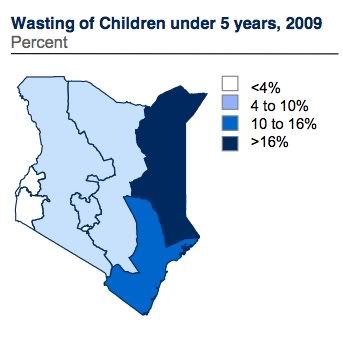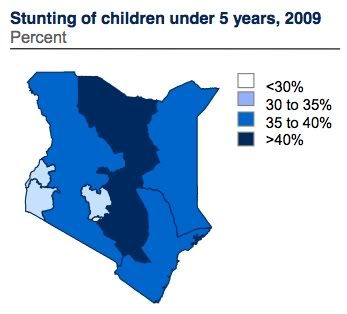Jill Richardson :: What Our Friends at USAID Are Up To in Kenya, Part 1
A document entitled "Strategic Review" from the Feed the Future program in 2010 shows what is likely a powerpoint presentation on Kenya. It includes several maps, and honestly, I can't make heads or tails of them. One of them shows poverty in terms of density (density of poor people in an area). As you might guess, where there are more people, there are also more poor people. I don't find that nugget of information very useful.
Next are maps of malnutrition and food insecurity by percent of the population, not absolute number. These are more helpful - or should be - but they have a bit of conflicting data. That is, where the children are the most stunted, they are not the most wasted. (Stunted means low height for age; wasted means low weight for height. Stunting is due to chronic malnutrition, whereas wasting is due to acute malnutrition.) However, the area with the most stunting is also the area with the highest food insecurity. The high population areas seem to have the least amount of malnutrition and food insecurity as a percent of the population, but might have higher absolute numbers of both because they just plain have more people, both rich and poor, well-fed and malnourished. Coast province (the southeastern most province) seems to be moderately bad but not the worst in all three measures.



Out of Kenya's population of 38.6 million people, some 17.8 million are considered poor. Those break down as follows: 7.2 million live in rural areas with high rainfall; 5.5 million are urban poor; 2.9 million live in semi-arid rural areas; and 2.2 million live in arid rural areas. They broke the country down into the following regions:

They chose which areas to focus on based on three factors. First, which regions have the most rural poor? HR1, HR2, SA2, and A2. Of those, which produce the most food? That eliminates A2. From there, which set of regions would represent the most diverse group of people receiving aid? That narrows it down to HR1 and SA2.
As I've noted before, Kenya's ethnically very diverse. The map used by USAID shows Kikuyu majorities in Western and Central provinces. Nyanza province is Luo and Kisii. My friend who I will visit there in Luo. Rift Valley is mostly Kalenjin. North Eastern province and the northern half of Eastern province are dominated by a Somali majority. The southern half of Eastern Province (SA2) is a mix of Kamba, Embu, and Meru. Last, Coastal province (in the southeast) is a mix of Mijikenda, Taita, and Swahili.
Here's an excerpt from a longer, more detailed version of USAID's plan in Kenya.
As part of their intrinsic market-based approach, all Mission value chain programs will be coordinated closely with USAID/EA programs in promoting private- sector-led market and trade development and regional integration and investment.
At the same time, to ensure access to food in lower potential areas, the USG through the Mission and partners will make markets work better for the poor and for women by investing in affordable inputs, delivery of services adapted to their needs, and development of better market linkages.
In other words, they want to turn peasants into entrepreneurs.
In 2010, they planned to focus on 5 areas:
1. Staple food value chain development, including livestock and livestock products;
2. Rural finance;
3. Policy analysis, advocacy and capacity-
building;
4. Agricultural research and technology transfer, and
5. Water and sanitation.
#1. Staple Food Value Chain Development
They list "Current and Potential USG and Development Partners" as:
USDA's Animal & Plant Health Inspection Service (APHIS)
USDA's Foreign Agriculture Service
USAID East Africa
Foreign Commercial Service
U.S. State Dept
Peace Corps
Agricultural Sector Coordination Unit (Govt of Kenya)
Dept for International Development (UK)
EU
UN Food & Agriculture Organization (FAO)
International Fund for Agricultural Development
Japan International Cooperation Agency
World Bank
Kenya Agricultural Research Institute (KARI)
Kenya Bureau of Standards
Kenya Dairy Board
Kenya Plant Health Inspectorate Services
Eastern Africa Grain Council
Kenya Livestock Marketing Council
UNICEF
UN World Food Programme
Gates Foundation
Rockefeller Foundation
Alliance for a Green Revolution in Africa
This investment focuses on improving agricultural productivity through value-added techniques, market linkages, diversification, and off farm income generation. Farmers will be linked to input and output markets through private agribusiness...
Two early areas being targeted are: 1) expanding smallholder farmer participation in structured grain markets, allowing greater use of the nascent grain warehouse receipts system for maize and staple food crops; and 2) addressing key market and trade constraints, including animal health sanitary issues, within livestock value chains.
Programs include: Kenya Maize Development Program (KMDP), Staple Food Crops Program, Kenya Dairy Sector Competiveness Program (KDSCP), Kenya Horticulture Competitiveness Program (KHCP), Kenya Access to Rural Finance (KARF), Drylands Livestock Development Program, and WFP pilot program Purchase for Progress (P4P).
And check this one out:
To further sound market-based policies for agriculture, the Mission value chain programs will undertake interventions to improve the institutional, policy and regulatory environment. They will continue to collaborate with USAID/EA programs such as COMPETE and the USAID/East Africa pastoral livestock and livelihoods activities, to promote policy initiatives and institutional structures that foster more and efficient marketing and trade of food crops and livestock. This includes harmonized commodity standards and inspection systems in the region.
This collaboration will be furthered through expansion of the Eastern Africa Grain Council's Grain Warehouse Receipts System and the strengthening of regional markets for livestock. The Mission will continue to engage with the Kenya Food Security Steering Group to improve early warning systems and build capacity to better integrate data and methodologies with the WFP G/EWS and FAO FAOSTAT systems.
This is getting long, so I'm going to end it here and continue in another post in the next day or so. Ultimately, I'd like to dig deeper into what each of these programs does and where each one is operating.
http://www.lavidalocavore.org/diary/4974/what-our-friends-at-usaid-are-up-to-in-kenya-part-1
A document entitled "Strategic Review" from the Feed the Future program in 2010 shows what is likely a powerpoint presentation on Kenya. It includes several maps, and honestly, I can't make heads or tails of them. One of them shows poverty in terms of density (density of poor people in an area). As you might guess, where there are more people, there are also more poor people. I don't find that nugget of information very useful.
Next are maps of malnutrition and food insecurity by percent of the population, not absolute number. These are more helpful - or should be - but they have a bit of conflicting data. That is, where the children are the most stunted, they are not the most wasted. (Stunted means low height for age; wasted means low weight for height. Stunting is due to chronic malnutrition, whereas wasting is due to acute malnutrition.) However, the area with the most stunting is also the area with the highest food insecurity. The high population areas seem to have the least amount of malnutrition and food insecurity as a percent of the population, but might have higher absolute numbers of both because they just plain have more people, both rich and poor, well-fed and malnourished. Coast province (the southeastern most province) seems to be moderately bad but not the worst in all three measures.



Out of Kenya's population of 38.6 million people, some 17.8 million are considered poor. Those break down as follows: 7.2 million live in rural areas with high rainfall; 5.5 million are urban poor; 2.9 million live in semi-arid rural areas; and 2.2 million live in arid rural areas. They broke the country down into the following regions:

They chose which areas to focus on based on three factors. First, which regions have the most rural poor? HR1, HR2, SA2, and A2. Of those, which produce the most food? That eliminates A2. From there, which set of regions would represent the most diverse group of people receiving aid? That narrows it down to HR1 and SA2.
As I've noted before, Kenya's ethnically very diverse. The map used by USAID shows Kikuyu majorities in Western and Central provinces. Nyanza province is Luo and Kisii. My friend who I will visit there in Luo. Rift Valley is mostly Kalenjin. North Eastern province and the northern half of Eastern province are dominated by a Somali majority. The southern half of Eastern Province (SA2) is a mix of Kamba, Embu, and Meru. Last, Coastal province (in the southeast) is a mix of Mijikenda, Taita, and Swahili.
Here's an excerpt from a longer, more detailed version of USAID's plan in Kenya.
As part of their intrinsic market-based approach, all Mission value chain programs will be coordinated closely with USAID/EA programs in promoting private- sector-led market and trade development and regional integration and investment.
At the same time, to ensure access to food in lower potential areas, the USG through the Mission and partners will make markets work better for the poor and for women by investing in affordable inputs, delivery of services adapted to their needs, and development of better market linkages.
In other words, they want to turn peasants into entrepreneurs.
In 2010, they planned to focus on 5 areas:
1. Staple food value chain development, including livestock and livestock products;
2. Rural finance;
3. Policy analysis, advocacy and capacity-
building;
4. Agricultural research and technology transfer, and
5. Water and sanitation.
#1. Staple Food Value Chain Development
They list "Current and Potential USG and Development Partners" as:
USDA's Animal & Plant Health Inspection Service (APHIS)
USDA's Foreign Agriculture Service
USAID East Africa
Foreign Commercial Service
U.S. State Dept
Peace Corps
Agricultural Sector Coordination Unit (Govt of Kenya)
Dept for International Development (UK)
EU
UN Food & Agriculture Organization (FAO)
International Fund for Agricultural Development
Japan International Cooperation Agency
World Bank
Kenya Agricultural Research Institute (KARI)
Kenya Bureau of Standards
Kenya Dairy Board
Kenya Plant Health Inspectorate Services
Eastern Africa Grain Council
Kenya Livestock Marketing Council
UNICEF
UN World Food Programme
Gates Foundation
Rockefeller Foundation
Alliance for a Green Revolution in Africa
This investment focuses on improving agricultural productivity through value-added techniques, market linkages, diversification, and off farm income generation. Farmers will be linked to input and output markets through private agribusiness...
Two early areas being targeted are: 1) expanding smallholder farmer participation in structured grain markets, allowing greater use of the nascent grain warehouse receipts system for maize and staple food crops; and 2) addressing key market and trade constraints, including animal health sanitary issues, within livestock value chains.
Programs include: Kenya Maize Development Program (KMDP), Staple Food Crops Program, Kenya Dairy Sector Competiveness Program (KDSCP), Kenya Horticulture Competitiveness Program (KHCP), Kenya Access to Rural Finance (KARF), Drylands Livestock Development Program, and WFP pilot program Purchase for Progress (P4P).
And check this one out:
To further sound market-based policies for agriculture, the Mission value chain programs will undertake interventions to improve the institutional, policy and regulatory environment. They will continue to collaborate with USAID/EA programs such as COMPETE and the USAID/East Africa pastoral livestock and livelihoods activities, to promote policy initiatives and institutional structures that foster more and efficient marketing and trade of food crops and livestock. This includes harmonized commodity standards and inspection systems in the region.
This collaboration will be furthered through expansion of the Eastern Africa Grain Council's Grain Warehouse Receipts System and the strengthening of regional markets for livestock. The Mission will continue to engage with the Kenya Food Security Steering Group to improve early warning systems and build capacity to better integrate data and methodologies with the WFP G/EWS and FAO FAOSTAT systems.
This is getting long, so I'm going to end it here and continue in another post in the next day or so. Ultimately, I'd like to dig deeper into what each of these programs does and where each one is operating.
http://www.lavidalocavore.org/diary/4974/what-our-friends-at-usaid-are-up-to-in-kenya-part-1











No comments:
Post a Comment